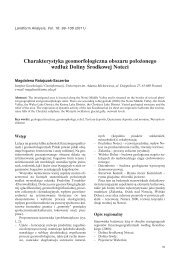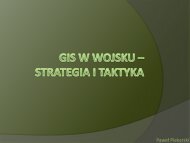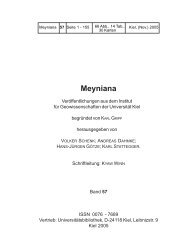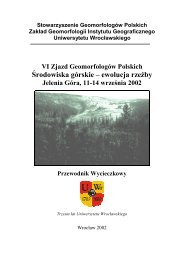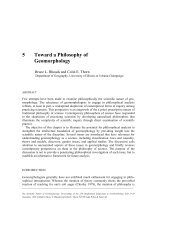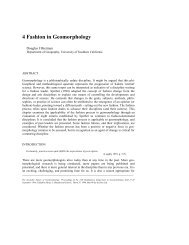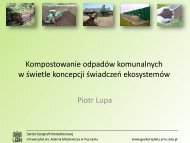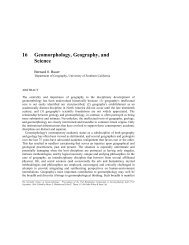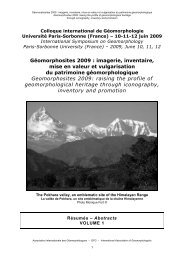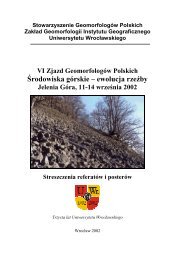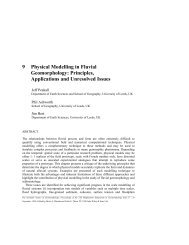Chapter 16 - Geomorphology, Geography, and Science Bernard 0
Chapter 16 - Geomorphology, Geography, and Science Bernard 0
Chapter 16 - Geomorphology, Geography, and Science Bernard 0
You also want an ePaper? Increase the reach of your titles
YUMPU automatically turns print PDFs into web optimized ePapers that Google loves.
GEOMORPHOLOGY, GEOGRAPHY, AND SCIENCE 399<br />
science seems less certain, especially in the contemporary academic climate. In the eyes of<br />
the public, geology is a science <strong>and</strong> geography is about maps, capital cities, <strong>and</strong> longest<br />
rivers. In the eyes of the physicist or chemist, geology is a 'soft' science <strong>and</strong> geography is<br />
about maps, capital cities, <strong>and</strong> longest rivers. In the eyes of the economist or sociologist,<br />
geology is a 'hard' science <strong>and</strong> geography is sometimes useful. In the eyes of the artist,<br />
geology <strong>and</strong> geography are fascinating. Most geologists, in contrast, consider themselves<br />
to be fundamentally scientific. Most geographers also consider themselves to be scientific,<br />
although some choose to differentiate between natural <strong>and</strong> social science, whereas others<br />
reject science <strong>and</strong> all that it st<strong>and</strong>s for. Are all these views accurate, <strong>and</strong> what are the<br />
implications for geomorphology?<br />
Most geomorphologists believe that geomorphology is a science. The title of this<br />
symposium presumes this very stance, <strong>and</strong> Rhoads <strong>and</strong> Thorn (1993) offer an informative<br />
framework within which to examine its rationality. Nevertheless, the difficult work of<br />
arguing geomorphology's status as a scientific discipline remains to be done. I doubt<br />
whether many geomorphologists have actually contemplated their research within the<br />
framework of a scientific method or even interrogated their implicit claims to being<br />
scientific. Fortunately, just 'appearing scientific' can be advantageous because the existing<br />
intellectual <strong>and</strong> social structure of academe rewards this position with respectability.<br />
Adopting a scientific stance is a matter of convention rather than conscious choice in most<br />
disciplines, <strong>and</strong> it may not reflect actual practice.<br />
Prescriptions for scientific practice have been examined in detail by many philosophers<br />
including Kuhn, Popper, Feyerabend, Bhaskar, Lakatos, <strong>and</strong> Chalmers, <strong>and</strong> I do not wish<br />
to engage these complicated debates further. The reader is referred to Haines-Young <strong>and</strong><br />
Petch (1986) <strong>and</strong> Rhoads <strong>and</strong> Thorn (1994) for cogent summaries of philosophical debates<br />
as they relate to geomorphology <strong>and</strong> physical geography. It is fair to say, however, that<br />
out of these debates comes one conclusion: it is extraordinarily difficult to come up with a<br />
definition of science that is, at the same time, mutually agreeable to all scientists,<br />
exclusionary of nonscientific endeavors, prescriptive of the practice of science, <strong>and</strong> a<br />
realistic portrayal of the history of scientific investigation in all disciplines. An example<br />
will serve the point well. Several years ago, while arguing the case for inclusion of an<br />
introductory physical geography course within the curriculum of the 'Natural World'<br />
subcategory of the General Education program, I found myself defending against repeated<br />
attacks against a few of the laboratory exercises on the grounds that they were not<br />
sufficiently scientific. I questioned the criteria on which these judgments were being<br />
made, but none of the panelists were able to provide an informative response. Their weak<br />
criticism was that these geography exercises had no 'h<strong>and</strong>s-on' component that required<br />
students to be in a laboratory setting using scientific instruments. Despite the absence of<br />
articulated criteria defining a laboratory exercise, they held firm to their belief that it was<br />
generally understood what constitutes a scientific laboratory exercise <strong>and</strong> that they could<br />
easily pass judgment. Among the examples they offered was the 'classic' biology<br />
experiment of frog dissection. This intrigued me, <strong>and</strong> I asked them how it was that cutting<br />
open a frog <strong>and</strong> looking inside its belly constituted a scientific experiment as opposed to<br />
simple observation. Where was the theory? What was the hypothesis? What was being<br />
tested? How were the results evaluated critically? And if such dissection constituted<br />
science, how was it different from a geographer or geologist examining a topographic map<br />
or stereoscopic air-photo pair <strong>and</strong> taking measurements of terrain attributes? They finally



